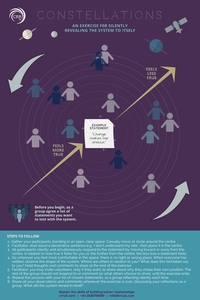Constellations

Individuals express their response to a statement or idea by standing closer or further from a central object. Used with teams to reveal system, hidden patterns, perspectives.
Goal
Reveals the system of beliefs, feelings, thoughts, etc. with all involved
Allows team to see patterns that are otherwise invisible
Allows exploration of physical expression, felt sense of truth
Creates a sense of connection, trust, curiosity
Allows non-verbal response
Materials
Instructions
Gather group in open room. Will read a statement & you'll decide how you feel about that statement. Place item in the middle that is the topic. Closer to this item means agreement/true, further from the item means non-alignment / not true for you.
Have people walk around at random in silence
Read the statement, people arrange themselves in proximity to the center object and stop moving.
Go to one person, stand next to them, ask questions such as
1. Why are you standing where you are standing? (or What has you standing here)
2. What's it like to stand here?
To focus on revealing the larger pattern, only ask one or two questions and move on to another person. Standing next to the person when you ask the question(s) (not facing them) signals you are with them, empathy, coaching perspective. We are curious about people's *relationship* to the central focus, not the content or fixing. Who is this person in relationship to the topic? What is this system in relationship to the statement?
Then have the group walk around again, read a new statement for the group to relate to and come into a new formation.
Facilitation notes & variations
For the center statement, create neutrally phrased statements.
ie. "I have the resources I need to succeed at my job"
Propose a series of related statements to get at different angles on the same topic and give different people opportunities to share. You can also use the center statement to be a concept "I am X" topic and then prompt people to consider different personal scenarios, walking around between each one.
To preserve data -- put colored dots on the floor to show where people ended up & later graph those dots.
Debrief questions from Marita Fridhon (~30 min in podcast)
3 questions
1. Establishing question - Where are you now (in relation to X topic)
2. Unfolding question - tests the truth of what was just said. How engaged are you in making changes around X?
3. Future question: How engaged do you want to be?
Dialogue question: What will have you disengage (relative to how you want to be engaged)?
Result: The reason there is difficulty to accomplish X is ____. The suggestion that come from this system to make this better are ____.
Variation to preserve anonymity
Have everyone walk around, get a feel of their response, & then mark their responses on a card (to preserve anonymity).
Swap cards & share from the perspective of another (empathy activity)
Collect cards & graph responses
Online variations
- Use a whiteboard program like Miro or Zoom whiteboard for people to move their locations on the screen.
-Have people individually recreate the physical experience of relating before graphing. ie. designate a place in their physical space that has the meaning and have them physically move around in their space and then graph the results online.
Attachments
- Paper-Constellations-Infographic.jpg
Background
Detailed explanation: https://crruk.com/constellations-exercise/
Author
I lead a team that helps multi-stakeholder groups tackle high-stakes, complex work with clarity and connection. We design and guide strategic planning sessions, workshops, retreats, and conferences where people think well together, make sound decisions, and take coordinated action. Our team is trained in improvisational theater, and as active members of the International Applied Improvisation Network, we bring adaptable, creative methods that build trust, surface essential perspectives, and keep momentum strong. We also share what we know, offering facilitator training that blends inclusive process design with the flexibility and presence of improv.
More about author